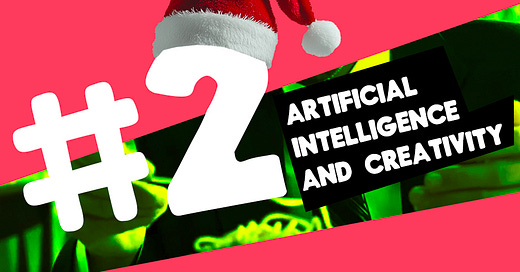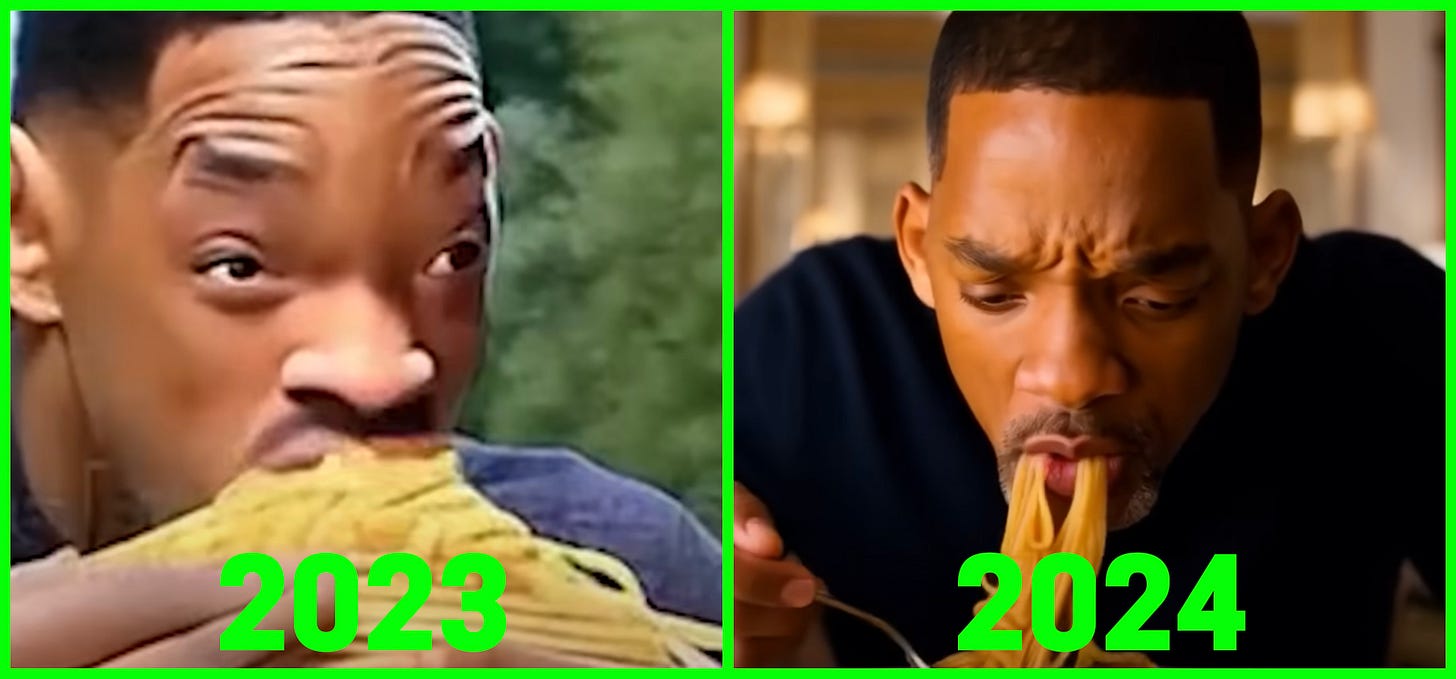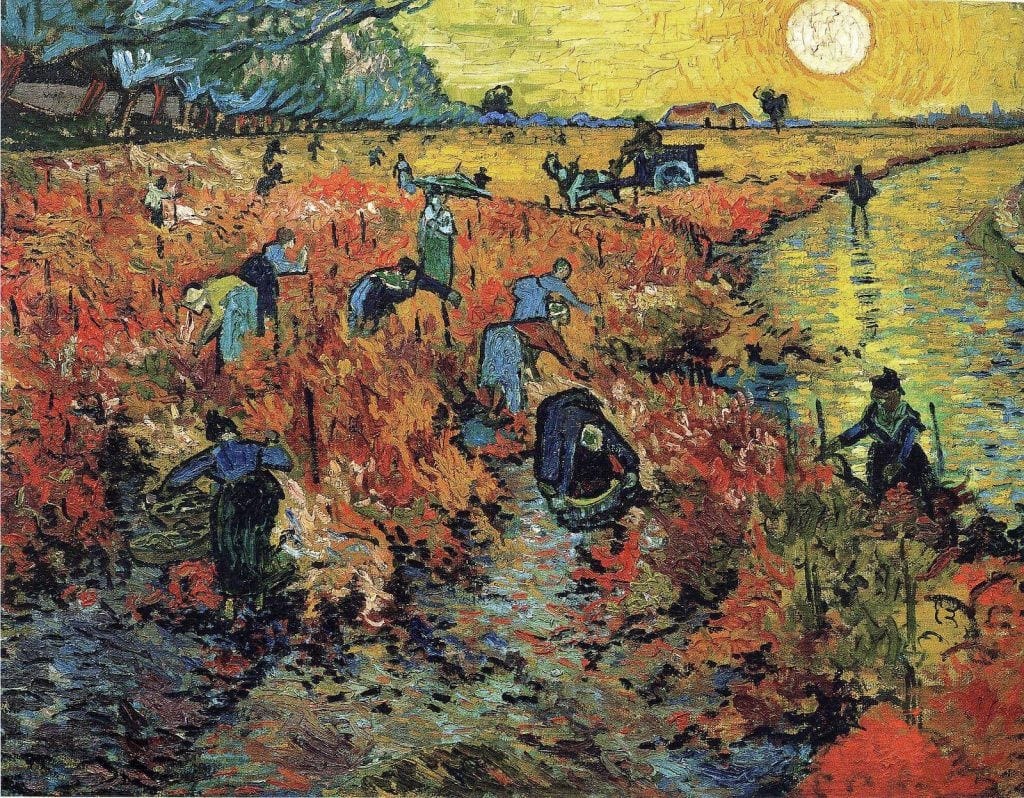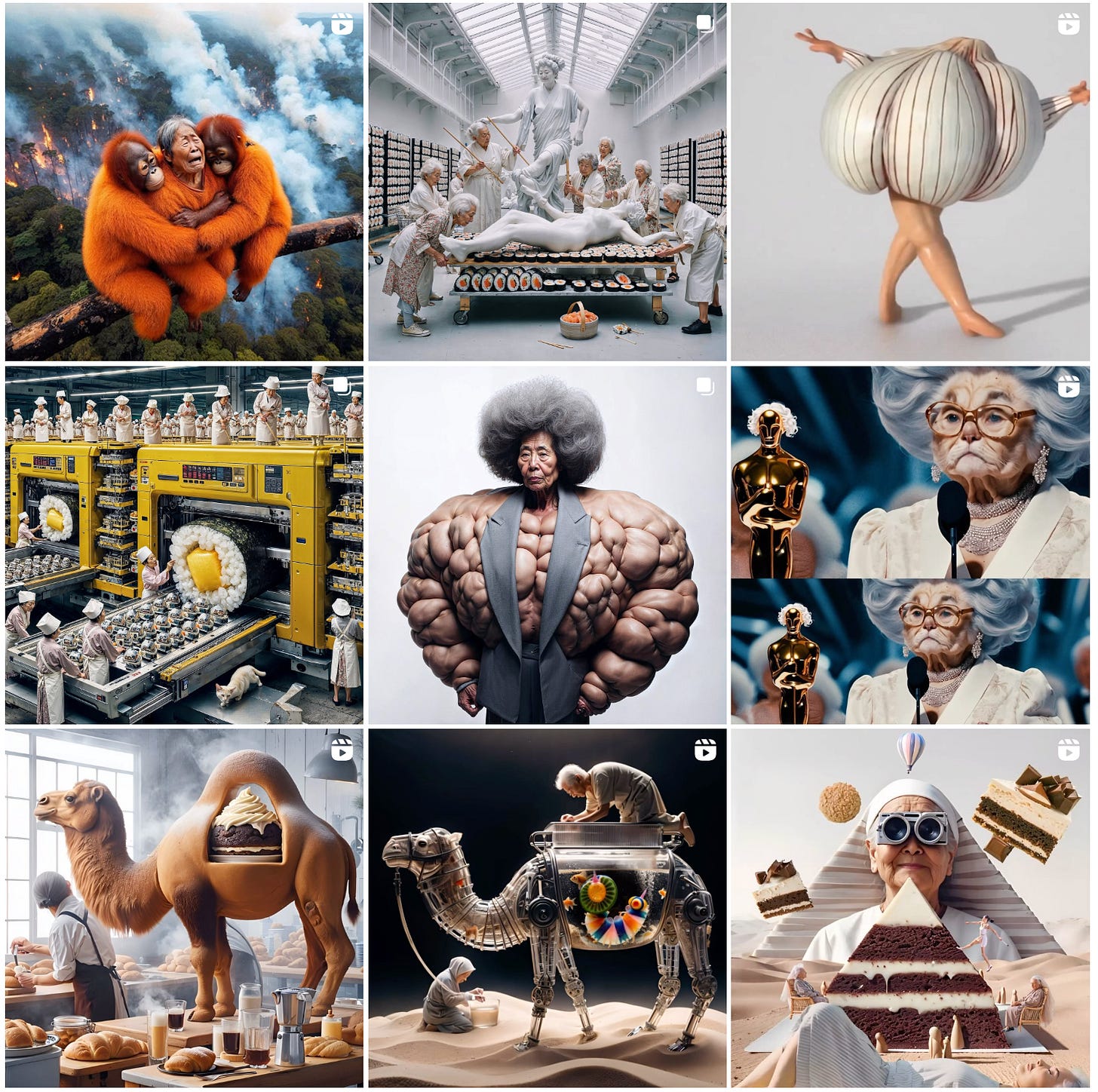Artificial Intelligence & Creativity
Benchy#2 -> Will Smith eating spaghetti, the rejection of innovation, Artificial creativity, Art at the center, Risks and hallucination
To close the year, let’s turn our attention to one of the most heated conversations of 2024 [and no, it’s not global warming]. Artificial Intelligence has dominated discussions, often centered on how to use it, its long-term impact on industries, and future trends. But this time, let’s shift the perspective. Instead of repeating the usual narratives, let’s examine AI through the lens of its impact on creativity.
WILL SMITH EATING SPAGHETTI
Just in 2023, the private investment in GEN AI reached U$95 BILLION1
We are living a new revolution2. The continuously evolving MVP's [Minimal viable products] of Artificial intelligences are in our hands for a couple of years now and it's progress is impressive, from here on with billions in investments every single year it will only get better.
As an example, the famous Will Smith eating pasta video, which weirdly enough, became a benchmark showing how AI is evolving [watch the original version from 2 years ago here and a recently created video bellow].
As this technology evolves, it's understandable that creatives may express concerns and even push back against the use of AI.
Questions like "Will it replace art forms?" "Could it threaten other creative fields?" and "What will happen to creative jobs?" are natural in face of such rapid change.
However, AI has also the potential to serve as a tool to creatives, bringing innovation and enhancing creativity overall, enabling new possibilities.
The challenges are several. How to integrate AI, ensuring it supports human creativity rather than undermining it, while addressing the broader implications not only for the creative industry, but major dilemas that goes from privacy to misinformation and keeps going to the pressing climate change and our need to act.
THE REJECTION OF INNOVATION
“People are very open-minded about new things— as long as they are exactly like the old ones”
This quote by Charles Kettering, is enlightening. Psychology talks on how challenging it is to embrace innovation. As humans, we are naturally inclined to resist change—our brains are wired to seek comfort and avoid uncertainty, which translates into a fear of failure. Innovating, is not just pushing your creative, but also an act of leadership, requiring courage to take risks to improving ecosystems and processes.
Innovation within products, brands, and marketing campaigns follows a similar cycle. To be truly innovative is to confront the fear of uncertainty and move forward despite it. It requires the courage to take risks and the accountability to own both the failures and the breakthroughs that emerge along the way.
As a customer, it's common to feel the ripple effects of innovation, even without being at its forefront. A striking example is the reaction to a drastic UI/UX update in a familiar service. Initially, it might feel disorienting or even inferior to the previous version. Yet, months later, the old design becomes a distant memory, while the new experience feels intuitive — as if it had always been that way, innovation takes time to take root.
Consider Van Gogh, who, throughout his life, managed to sell only a handful of his works. It was only after his death that his genius was widely recognized. Notably, The Red Vineyard is often cited as the only painting he sold during his lifetime.3
Compared with the 19th century, something that changed in the last decades is that the cycles of innovation are much shorter, the assimilation of any new technologies don't give us the time to stop breath and think through, it's always rushed.
Photography is another example, as once it appeared as a tool and a creative expression in the 19 century, had an enormous backlash4, in 1901, as the artist Henrietta Clopath voiced:
“The fear has sometimes been expressed that photography would in time entirely supersede the art of painting. Some people seem to think that when the process of taking photographs in colors has been perfected and made common enough, the painter will have nothing more to do”
Returning to artificial intelligence, the criticism surrounding text, image, and video quality — as well as AI's broader creative potential — runs deeper than debates about agility or MVP methodologies. While AI will inevitably master details like rendering hands correctly [and far more], it is not the first technology to face skepticism from the creative community at its debut.
Though definitive answers about the risks AI poses to the creative field remain open, academic research has already begun to probe its short- and long-term impacts on human creativity and the evolving nature of creative work.
ARTIFICIAL CREATIVITY?
It's said that ChatGPT reached one million users within just five days of its launch. More broadly, some reports suggest that by 2023, the global user base for AI tools surpassed 250 million, doubling since 2020, with projections indicating it could exceed 700 million by 2030.
It has undeniably become a culturally transformative topic across industries. As Amy Webb, a renowned futurist and CEO of the Future Today Institute, noted in the institute's report5, this shift paves the way for broader discussions among academics and creativity experts.
By understanding its size and the plausible coefficient of change it can bring, more scientists have been driven to research AI. Looking at material published in The Journal of Creativity and other academic sources between 2023 and 2024, here are some key findings on the topics and questions these studies raise. [Please refer to the footnotes for a list of articles that informed this section.6]
→ AI as a tool
Scientists have been exploring different frameworks for how humans can collaborate with AI as a tool. One approach is the Cyborg model, where human and AI contributions are so interwoven that the process becomes indistinguishable. In contrast, the Centaur model establishes clear boundaries, with distinct tasks assigned to each — X is owned by AI and Y is owned by humans — much like oil and water, which remain separate even when combined.
Regardless of these classifications, different studies have explored the impact of AI on human creativity by dividing participants into two groups, let's call: Group A, which uses AI in collaboration with humans to enhance their output, and Group B, composed solely of humans. These studies often ask participants to create an original story, develop a marketing campaign or similar case studies. The results tend to follow a consistent pattern: [Human] judges, evaluating the ideas, frequently select Group A as the winner, as the ideas generated, consistently outperform Group B.
However, an important finding is that usually the creative outputs from AI-assisted groups tend to be more homogeneous among themselves, with less variation in originality and overall delivery when compared with other groups also using AI.
In contrast, Group B composed only by humans, tends to displays greater originality and diversity.
if an idea is not original and merely "good enough," can it still be considered creative? Or is it simply navigating within the boundaries of established conceptions? If it only manages to be passable, does it truly qualify as creativity, or is it just an iteration of the status quo?
This suggests that over-reliance on AI could lead to creative uniformity, raising important questions about the balance between efficiency and originality.
Another perspective that adds granularity to the discussion is the notion that perception of effort influences how creativity is judged. When evaluators know that an idea was generated by AI, there is often a preconceived bias that associates AI with low effort, leading them to perceive the outcome as less creative. In contrast, when judges are unaware of AI's involvement, their evaluation of the idea tends to shift, often focusing solely on the quality of the result rather than the process behind it.
Beyond this, groups that over relied on AI had some issues that more experienced humans with tacit knowledge didn't have. over-reliance on AI introduces other concerns, such as machine hallucinations — instances where AI generates false or misleading information. [More on this to come.] It also raises broader issues related to reduced human-to-human interaction.
→ Leveling up performances
One of the more promising insights from these studies is AI's potential to level the creative playing field. In simpler terms, AI can raise the performance of individuals with lower creative output, enabling them to achieve results closer to those of top-tier performers. Interestingly, even high-performing creatives benefit from AI support, also showing strong gains in performance.
This finding highlights AI's potential as an equalizer within creative spaces, making advanced creative work more accessible to people with varying levels of skill and experience.
→ Intentionality vs. Interpretation
When AI generates something "new," it has neither consciousness nor the intent to create. Unlike humans, who imbue their work with meaning and purpose, AI's creations are byproducts of rules, statistical models, and prior training data. What we interpret as "creative" in AI-generated work is, in fact, a reflection of our own human perception of novelty.
→ Real experiences
While AI excels at storing, processing, and learning from vast datasets, it lacks the ability to experience the world as humans do. It has no senses, no access to the emotional triggers that humans rely on for creative inspiration.
This difference is fundamental. For example, walking into a restaurant and smelling a dish that reminds you of your grandmother’s cooking can influence a creative decision — something AI cannot replicate.
Going back to the 19th century, Van Gogh infused his drawings with his emotions and. thoughts, embedding his sentiments into his work. This is what made him extremely successful in the decades to come.
AI, on the other hand, creates by combining learned patterns, it's algorithm. is made to please you — it will never know what it feels like to be moved by a memory or learn by serendipity. It can recognize and reproduce patterns, but it cannot feel.
To close, here is an amazing quote from a 2023 article in The New York Times written by David Means.7 [Read this article if you can, amazing!]
A.I. will never be able to do what I can do because A.I. has never felt what I’ve felt. It will never move through the emotional matrix of living a singular, individual life.
ART AT THE CENTER
Art is an expression of creative thinking that enables us to share ideas through diverse processes, moving away obvious answers to inspire and broaden perspectives. Reflecting on art creates an understanding of how creativity has the power to transform individuals, organizations, and societies.
Artists have been increasingly using AI for experimentation with new forms, processes, and interactions. By creating and occupying unexplored creative spaces, AI becomes a medium for innovation, enabling artists to push beyond the limits of their own imagination. The following examples highlight how AI empowers creativity, with each artist’s work diverging in unique and unpredictable ways, more than the tool itself, reflecting their individual visions.
NICE AUNTIES8 →
An art project by a Singaporean designer and artist, inspired by the women in her large family that celebrates their unique personalities, strength, eccentricity, and humor.
AI, as a medium and as a tool, enabled her to do more than just create images, expanding her creations to tell stories within the universe she called the Auntieverse.
niceaunties is an art project about aging, beauty freedom & fun.
In an interview for Forbes9 this is how Nice Aunties expressed her role as an artist in society:
The role of an artist is to express their opinions or perspectives in their own unique way, hopefully to spark conversations and positive change. I hope to bring people new energy, and inspire them to celebrate their own uniqueness and the joy of self-expression.
REFIK ANADOL10 →
What would a machine mind dream of after “seeing” the vast collection of The Museum of Modern Art?
This is the concept created behind one of Anadol's works, exihibited at MoMa. Known for his work mixing art and technology, Anadol uses AI to process datasets, transforming them into mesmerizing, dynamic visual experiences.
Recently, in his work titled “Machine Hallucinations,” a process involving 138,151 images from MoMA’s collection was used to generate a real-time video that simulates what a machine might "dream" when exposed to such a vast visual archive. The output is a continuous stream of abstract, ever-evolving visuals, driven by patterns drawn from the collected data.
What makes this concept particularly compelling is that AI is not merely a tool but also a live, dynamic medium. The artwork exists in a state of constant flux, endlessly reconfiguring itself based on the dataset, embodying a process that resists being fixed or finalized.
Ai-Da11 →
This represents a completely different view and usage of AI. Ai-Da is said to be the first robot and AI artist. Her very existence poses a question meant to provoke reflection on the future of society, where robots and humans may coexist in a world where humanism might no longer be at the center.
Her composite persona is the artwork, along with her drawings, performance art and collaborative paintings and sculptures.
On the website, it is stated that Ai-Da is a machine built from a fusion of electronic, AI, and human inputs, with her artwork described as a machine-human collaboration. This concept remains closely aligned with the broader discussion of AI as a tool, where human and machine output mix together — even in this edge case of a fully functional and autonomous robot.
Recently AI-Da sold the portrait "AI God: Portrait of Alan Turing" for $1.08 million, setting a record for an artwork created by a humanoid robot.12
The piece reimagines Turing, the father of modern computing, through a composition of facial studies, each reflecting the algorithm's unique interpretation of his image, As AI-Da can't paint on big frames [yet] the work was done within smaller canvas, then merged and printed in a 3d textured printer. The portrait invites reflection on Turing's legacy while evoking broader questions about AI’s role in shaping human creativity and perception.
The key value of my work is its capacity to serve as a catalyst for dialogue about emerging technologies.
RISKS AND HALLUCINATION
To close, it’s essential to address the risks and challenges AI must overcome, from regulatory frameworks to environmental impact, a range of issues demands attention.
A key point of debate is about AI hallucination, which occurs when an AI generates false information, fabricating facts and responses. This is why users are often advised by the platforms themselves to verify AI outputs, as reliance on AI increases susceptibility to errors.
The causes of hallucination are multifaceted. Data gaps and algorithmic design play a role, with AI preferring to maintain conversational flow rather than admitting uncertainty, in the end these AI platforms wants to please you just as streaming and social media algorithms, which often prioritize engagement over diversity, encouraging users to remain on the platform by watching or consuming content types they know will make us stick more.
Ironically, in the context of creativity, hallucination is desirable. Divergent thinking — the ability to produce unexpected, original content — is a key aspect of creative production. This duality presents a challenge: how do we control hallucination for factual accuracy while encouraging it for creative purposes?
The World Economic Forum highlights this issue as the second most critical risk13 facing society in the next 2 years.
The future of AI depends on how we, as a society, address these risks. As with any transformative revolution, its path will be shaped by collective thinking, reflection, and debate, offering a chance to guide AI toward an ethical and sustainable future.
THANKS
This edition was a joy to write. Over the past six months, I’ve been studying a lot of creativity and AI in my free time, for fun and as part of my preparation for a master's. It’s a topic I’m passionate about, and I hope that energy comes through in the text.
I also have to disclose, I have a glass-half-full perspective, I see AI as a tool that, like photography did for painting, will amplify creative potential rather than replace it. I believe the heart of creation isn’t the tool itself but the originality, references, and creative thinking. AI, in this view, becomes an enabler and amplifier for human expression.
As the year closes, I hope you all take time off to rest and enjoy moments with family. We work too much for it to be healthy, so let’s embrace the pause — it’s just as essential as the work itself. Rest well and recharge!
🗓️ NEXT MONTH: Next up! already in the oven ready to be cooked, humanity! [Just joking, but not that much], let's talk about products and brands focused with one single ideal: sustainability, that seems a good topic to start the year.
👣 FOOT NOTES → There is always more to read, here some of the content mentioned, if you want to expand your knowledge.
Stanford AI report → https://aiindex.stanford.edu/report/
Forbes, AI revolution → https://www.forbes.com/councils/forbestechcouncil/2023/09/12/harnessing-ai-and-chatgpt-technology-the-next-industrial-revolution/?utm_source=chatgpt.com
Van Gogh Museum → https://www.vangoghmuseum.nl/en/art-and-stories/vincent-van-gogh-faq/how-many-paintings-did-vincent-sell-during-his-lifetime
History of photography → https://daily.jstor.org/when-photography-was-not-art/
Tech trend report → https://futuretodayinstitute.com/wp-content/uploads/2024/03/TR2024_Full-Report_FINAL_LINKED.pdf
Scientific articles used to build up this section:
→Navigating Generative Artificial Intelligence Promises and Perils for Knowledge and Creative Work: https://www.sciencedirect.com/science/article/pii/S2713374523000225
→AI can only produce artificial creativity: https://www.researchgate.net/publication/377100552_Navigating_Generative_Artificial_Intelligence_Promises_and_Perils_for_Knowledge_and_Creative_Work
→Artificial intelligence as a tool for creativity: https://www.sciencedirect.com/science/article/pii/S2713374524000050?via%3Dihub
→ When and How Artificial Intelligence Augments Employee Creativity: https://www.researchgate.net/publication/369589868_When_and_How_Artificial_Intelligence_Augments_Employee_Creativity
A.I. Can’t Write My Cat Story Because It Hasn’t Felt What I Feel → https://www.nytimes.com/2023/03/26/opinion/ai-art-fiction.html
Nice Aunties → https://niceaunties.com/
Forbes Interview → https://www.forbes.com/sites/yjeanmundelsalle/2024/11/25/artist-niceaunties-uses-ai-crafted-surreal-worlds-to-rebel-against-societal-norms-imposed-on-women/
Refik Anadol → https://refikanadol.com/
AI-da Robot → https://www.ai-darobot.com/
AI-da CNN → https://edition.cnn.com/2024/11/08/style/ai-da-portrait-alan-turing-record-sale-intl-scli/index.html
World Economic Forum, Global risks 2024 report → https://www.weforum.org/publications/global-risks-report-2024/















